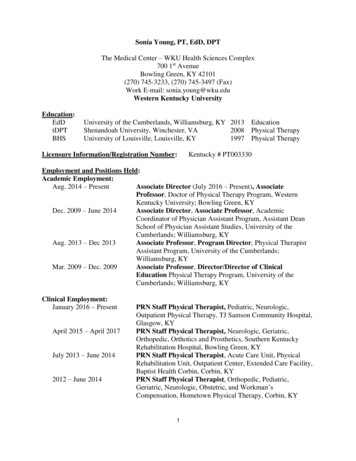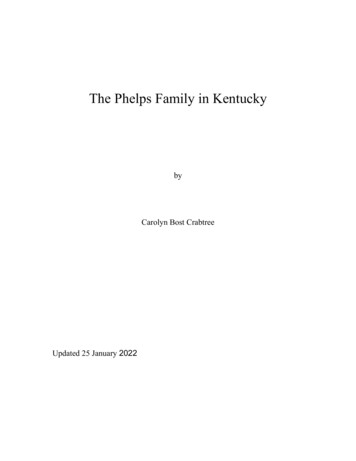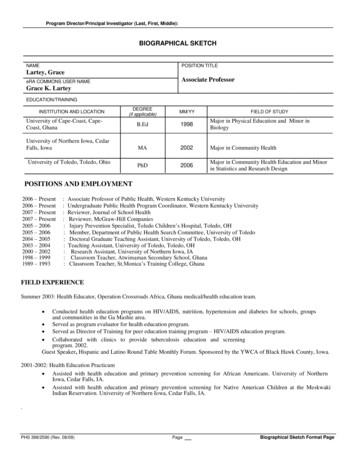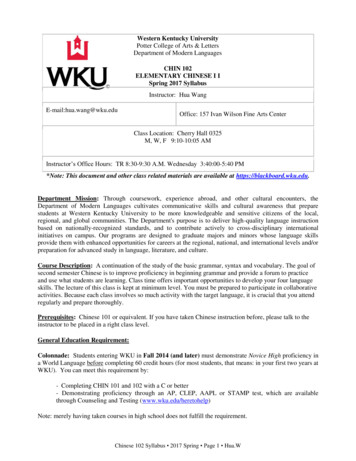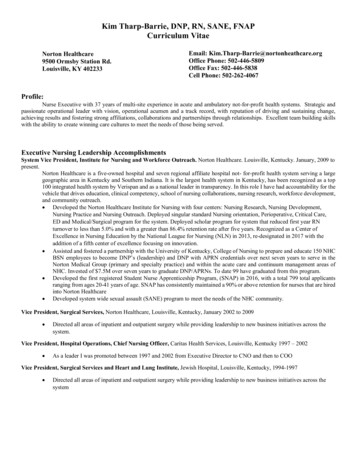
Transcription
Western Kentucky UniversityAdvancing PsychologicalResearch with TechnologyREU (Research Experience forUndergraduates) Program2nd Annual REUResearch ConferenceAugust 5, 2016This program was funded by National Science Foundation Award #1460942.
TABLE OF CONTENTSREU Program Overview . 1Summer Highlights . 2Student Spotlights 4Faculty Mentor Spotlights 6Conference Schedule . 7Research Abstracts .8Faculty Mentor & Student Contact Information .262
REU PROGRAM OVERVIEWWhat is the REU program?The Research Experience for Undergraduates (REU) program providedundergraduate students enrolled in colleges and universities where there are limitedresearch opportunities with a unique opportunity to gain hands- on researchexperience on a topic related to the program theme, which focused on the utilizationor examination of technology as a means of advancing psychological research.Students spent 10 weeks (May 30, 2016 - August 5, 2016) working closely with afaculty mentor on research utilizing technological advances in the areas of clinical,cognitive, developmental, educational, industrial/organizational, and/or socialpsychology. Students also participated in developmental workshops and activitiesrelated to topics such as ethics, research methods, statistics, computer software,and presentation skills. At the conclusion of the program, students presented theirfindings at a mini research conference to university faculty and staff.What is the overarching purpose of the program?This program provided students with the opportunity to gain hands- on researchexperience while furthering our understanding of human behavior and cognition. Allstudents are expected to disseminate their research findings at a national orinternational conference following completion of the program, and students arestrongly encouraged to submit their research findings for publication. Our goal wasto have participants develop strong skills as psychological researchers, therebyincreasing the likelihood that program participants will pursue graduate degreesand/or careers in psychology.The theme of the REU site, which was focused on the integration of moderntechnology into psychological research, not only allowed students to gain exposureto working with cutting- edge technology not available in a number of psychologydepartments, but to also learn about research topics that are highly relevant totoday’s society. As such, the program provided participants with both a strong set ofresearch skills and a better understanding of modern issues being addressed in thefield of psychology.1
SUMMER HIGHLIGHTSWorkshops for Research and Professional DevelopmentLibrary resources and writing a literature reviewGuided literature review writingAPA expectations and ethicsExperimental designGRE preparationSPSS and Excel overviewWriting a method sectionGuided method writingStatistics and data analysisIs an academic career for you?Writing results and discussion sections and creating tables and figuresDeveloping your CV and personal statementBuilding and delivering presentationsMaintaining work- life balanceMock poster and oral presentation sessionsGetting into graduate schoolDeveloping interview skillsFaculty Brown Bag Research PresentationsCognitive Strategies (Dr. Jenni Redifer)Examining the Implications of Technology Use at Work (Dr. Amber Schroeder)It Isn’t Crazy if It Works: What We Know about Sport Fandom (Dr. Rick Grieve)Nonsuicidal Self- Injury and Suicidal Behaviors in Adolescents (and YoungAdults) (Dr. Amy Brausch)Applied data analysis: Data science and The Field of Institutional Research(Taylor Blaetz)Masculinity is Reactive: Mortality Salience Increases Masculine, but notFeminine, Self- Stereotyping (Dr. Aaron Wichman)Examining Individual Differences in Emotion Regulation (Dr. Diane Lickenbrock)Incremental Beliefs about Ability Ameliorate Self- Doubt Effects (Dr. Qin Zhao)Aging and Causal Judgment: Revision of Causal Beliefs (Dr. Sharon Mutter)How do Interest and Cognitive Ability Affect Mind Wandering during Reading?(Dr. Matthew Shake)Field Trips Exploring Local Culture and HistoryLost River Cave Boat Tour – Lost River Cave, Bowling Green, KYBelmont Mansion – Nashville, TN2
Thank you to the following faculty from the Psychological Sciences and Psychology Departmentswho led REU workshops, participated in research brown bags, and/or assisted with field trips:Diane Lickenbrock, Rick Grieve, Lance Hahn, Kelly Madole, Andy Mienaltowski, Sharon Mutter,Farley Norman, Amy Brausch, Jenni Redifer, Amber Schroeder, Aaron Wichman, Liz Lemerise,Qin Zhao, Matthew Shake, Reagan Brown, Amy Brausch, and Taylor Blaetz3
STUDENT SPOTLIGHTSLisa Dazzell is a rising junior at the City University of New YorkLehman College in Bronx, NY. She will graduate with a B.A. inPsychology in May 2018. After graduation, Lisa plans to apply todoctoral programs for clinical psychology and later conductclinical research on mental health disorders and their impact onindividuals from low socioeconomic backgrounds.Angela Engle is a senior at Webster University in St. Louis, MO.She will graduate with a B.A. in Psychology in December 2016.After graduation, Angela plans to apply to masters programs forclinical mental health counseling and pursue a career as alicensed professional counselor.Eva Frishberg is a senior at Bard College in Annandale- On- Hudson, NY. She will graduate with a B.S. in Psychology in May2017. After graduation, Eva plans to apply to Ph.D. programs inClinical Psychology and work in the field to address learningdisabilities.Jaroth Lanzalotta is a senior at Reed College in Portland, OR.He will graduate with a B.A. in Psychology in May 2017. Aftergraduation, Jaroth plans to apply to doctoral programs for socialpsychology and pursue a career as a professor, then take over theworld.4
Zoua Lor is a rising junior at St. Olaf College in Northfield, MN.She will graduate in May 2018 with a B.A. in Psychology and aconcentration in Statistics. Zoua plans to matriculate into aclinical/counseling psychology doctoral program. She aspires topractice psychology and pursue a career as a professor.Cody Mashburn is a senior at Young Harris College in YoungHarris, GA. He will graduate with a B.S. in Psychology and aminor in Philosophy in May 2017. After graduation, Cody plans toapply to Ph.D. programs in Cognitive Psychology and CognitiveNeuroscience to pursue a career as a professor.Kali Odd is a senior at Hastings College in Hastings, NE. She willgraduate with B.A. in Psychology and a minor in CommunicationStudies in January 2017. After graduation, Kali plans to apply toPh.D. programs in Industrial/Organizational Psychology andpursue a career as a professor.Makenna Snyder is a senior at Missouri Western StateUniversity in Saint Joseph, MO. She will graduate with a B.S. inPsychology with a minor in Wellness in May 2017. Makennaplans to apply for doctoral programs in occupational therapy andhopes to specialize in pediatrics as a practicing therapist andeventually conduct art- based intervention research.Catherine Woosley is going to be a senior at Western KentuckyUniversity. She will graduate in May 2017 with a B.S. inPsychological Sciences and a B.A. in Music. She will continue herstudy of psychology at Western Kentucky University working onher master’s in Psychological Sciences with a concentration inCognitive Development.5
Faculty Mentor SpotlightsDr. Amy Brausch is a Clinical Psychologist who joined the WKUfaculty in 2011 after completing her Ph.D. at Northern IllinoisUniversity. Her research currently examines non- suicidal self- injury inadolescents.Dr. Rick Grieve is a Clinical Psychologist who joined the WKU facultyin 2002 after completing his Ph.D. at the University of Memphis. Hisresearch currently examines men’s eating disorders, specificallymuscle dysmorphia.Dr. Sharon Mutter is a Cognitive Psychologist who joined the WKUfaculty in 1991 after completing her Ph.D. at George WashingtonUniversity. Her research currently examines how age- related changesaffect causal learning.Dr. Jenni Redifer is an Educational and Cognitive Psychologist whojoined the WKU faculty in 2012 after completing her Ph.D. at theUniversity of Florida. Her research currently focuses on examiningfactors related to student learning and achievement.Dr. Amber Schroeder is an Industrial- Organizational Psychologistwho joined the WKU faculty in 2012 after completing her Ph.D. atClemson University. Her research currently focuses on examining thevalidity of online social media use in organizational settings.Dr. Matthew Shake is a Cognitive Psychologist who joined the WKUfaculty in 2012 after completing his Ph.D. at the University of Illinois.His research currently examines how cognitive aging affects languageprocessing and comprehension.Dr. Qin Zhao is an Educational Psychologist who joined the WKUfaculty in 2008 after completing her Ph.D. at the University of Florida.Her research currently focuses on how to enhance metacognitiveability.6
CONFERENCE SCHEDULE9:00Oral Abstract SessionCessation of Nonsuicidal Self- Injury: How Do Those Who Desire to StopDiffer from Those Who Do Not?Presenter: Angela Engle Faculty Mentor: Dr. Amy BrauschSize Discrepancy: Actual vs. Ideal Body Image of Men with MuscleDysmorphiaPresenter: Lisa Dazzell Faculty Mentor: Dr. Rick GrieveUs vs. Them and Especially Them: Rival Derogation in Sport FansPresenter: Jaroth Lanzalotta Faculty Mentor: Dr. Rick GrieveA Comparison of Self- explanation and Practice Retrieval: Impacts onVerbatim Recall and Inference GenerationPresenter: Zoua Lor Faculty Mentor: Dr. Jenni RediferSelf Doubt Effects Depend on Beliefs about AbilityPresenter: Eva Frishberg Faculty Mentor: Dr. Qin ZhaoAmbiguity Leads to Context- Specificity in Predictive LearningPresenter: Catherine Woosley Faculty Mentor: Dr. Sharon MutterPredictive Learning Biases Selective Attention OrientationPresenter: Cody Mashburn Faculty Mentor: Dr. Sharon MutterBingocize: The Effect of Exercise Intervention on Cognition, FunctionalPerformance, and Health Behaviors in Older AdultsPresenter: Makenna Snyder Faculty Mentor: Dr. Matthew ShakeConsistently off the Mark: Examining Structure in the CybervettingProcessPresenter: Kali Odd Faculty Mentor: Dr. Amber Schroeder9:45Poster SessionStudents will present their research in more detail and answer questionsduring this session. See the list of oral abstracts for poster topics.12:30Invited SpeakerDr. Chaitra Hardison: Women on the Front Lines: Establishing PhysicalStandards for Ground- Combat Jobs7
RESEARCH ABSTRACTSSize Discrepancy: Actual vs. Ideal Body Image of Men With Muscle DysmorphiaLisa Dazzell & Frederick GrieveIntroductionThe current study was designed to examine size discrepancies between actualand ideal body shape in men with and without Muscle Dysmorphia (MD). MD is a bodydysmorphic disorder where individuals are preoccupied with the body and believe it tobe more underdeveloped than it actually is, when in fact, individuals with MD are leanand muscular, especially in comparison to the average person (American PsychiatricAssociation, 2013). Men typically have the disorder, and experience a larger sizediscrepancy between their self- reported and actual body image. Pope et al., (2000)verified the hypothesis that men want to be more muscular and lean than they currentlyare. However, subjects in the study were not screened for MD or asked to provideestimates of their actual body shape and size. It may be likely that men with MDexperience a greater desire for muscle mass than the average male.MethodParticipantsParticipants were 251 men aged 18 to 72 (M 30.7, SD 9.1), who workout atthe gym three or more times per week for at least 45 minutes at a time. Race/ Ethnicitywas composed of 25 Blacks or African Americans, 24 Hispanics or Latinos, 73Asians/Pacific Islanders, 118 Caucasians, 7 Native Americans or American Indians, and4 other. Participants were recruited from Amazon Mechanical Turk, and from WesternKentucky University.MeasuresMuscle Dysmorphia Questionnaire. The Muscle Dysmorphia Questionnaire(MDQ;; Grieve et al., 2014) is a 34- item self- report questionnaire examiningcharacteristics of MD on a six- point Likert- type scale, ranging from 1 (strongly disagree)to 6 (strongly agree).Bodybuilder Image Grid. The Bodybuilder Image Grid (BIG;; Hildebrandt,Langenbucher & Schlundt, 2004) is a 5x6 grid displaying several male body types andshapes with varying body fats and muscle masses (Williams, 2013).Fat- Free Mass Index. The fat- free mass index (FFMI;; Kouri, Pope, Katz, &Oliva, 1995) is a measure of height in relation to body weight, used to identify musclemass. FFMI W((1 – BF%)/100)H2 6.1 (1.8 H)ProcedureParticipants completed a 50- item questionnaire composed of eight demographicquestions, followed by five questions about their body, e.g., “What is your ideal weight?”After completing the body questions, participants took the MDQ followed by the BIG,where they indicated their actual and ideal body shape using the grid. The weight andheight provided by participants were used to calculate FFMI of actual and preferredbody type for each participant. The body fat measures were determined based on theBIG scale. Size discrepancy was found by calculating the difference between actualFFMI and Ideal FFMI.ResultsAn independent samples t- test revealed that there was a significant differencebetween the high and low MDQ score groups t (44) - 33.6, p .001. Participants in thehigh MDQ score group (M 151.19, SD 8.01) indicated higher scores on the MDQ8
than participants in the low MDQ group (M 65.32, SD 9.13). Another independentsamples t- test revealed no significant difference between the high MDQ score groupand the low MDQ score groups on body mass index (BMI), t (32.4) - .67, p .51.Further, an independent samples t- test revealed no significance between the high MDQscore group and the low MDQ score groups on actual muscle mass, t (41) - 1.31, p .20. Finally, an independent samples t- test revealed no significance between the highMDQ score group and the low MDQ score groups on ideal muscle mass, t (42) - 1.81,p .08.DiscussionThe results indicate that there is a difference in perceived actual and ideal bodyshape of participants. In general, men want to become more muscular. There is nodifference in people with high MD and people with low MD when it comes to actualmuscle mass, which indicates that people with MD think of themselves as smaller thanthe average person, when in fact they are either more muscular or average as well.While the difference between high MDQ score group and low MDQ score group andideal muscle mass was insignificant, the results of the independent t- tests indicate thatwe are off to a good start, and participants in the high MD score group would have agreater preferred ideal muscle mass. Future studies should be done on more men withMD, and researchers should take participant’s body measurements.ReferencesAmerican Psychiatric Association. (2013). Diagnostic and statistical manual ofmental disorders (5th ed.). Washington, DC: Author.Grieve, F. G., Short, J., Cubberley, R., Derryberry, W. P., Jones, E., Wilson, S.,Hanahan, M., Menser, S., Cyr, C., & White, M. (2014, May). Psychometricproperties of the Muscle Dysmorphia Questionnaire. Poster presented at theannual meeting of the Association for Psychological Science, Washington, D.C.Hildebrandt, T., Langenbucher, J., & Schlundt, D. G. (2004). Muscularity concernsamong men: Development of attitudinal and perceptual measures. Body Image,1, 169- 181.Kouri, E. M., Pope Jr, H. G., Katz, D. L., & Oliva, P. (1995). Fat- free mass indexin users and nonusers of anabolic- androgenic steroids. Clinical Journal of SportMedicine, 5, 223- 228.Pope, H. G. Jr., Gruber, A. J., Mangweth, B., Bureau, B., deCol, C., Jouvent, R.,& Hudson, J. I. (2000). Body image perceptions among men in three countries.American Journal of Psychiatry, 157, 1297- 1301.Williams, J. (2013). Muscle Dysmorphia, Body Disatisfaction, And Eating Attitudes InCollegiate- Aged Male Amateur Weightlifters (Doctoral dissertation, OklahomaState University).9
Cessation of Nonsuicidal Self- Injury: How Do Those Who Desire to Stop Differfrom Those Who Do Not?Angela Engle & Amy M. BrauschIntroductionNon- suicidal self- injury (NSSI) is defined as the deliberate destruction of one’sown tissue without intent to die and for reasons that are socially unacceptable (Nock,Joiner, Gordon, Lloyd- Richardson, & Prinstein, 2006). Individuals generally beginengaging in this behavior around the ages of 13 or 14, and it is found to be equallyprevalent among males and females (Klonsky & Muehlenkamp, 2007). A meta analysisreported a mean lifetime prevalence rate of NSSI as 18% internationally (Muehlenkamp,Claes, Havertape, & Plener, 2012). However, there is no literature comparingindividuals who report wanting to stop self- harming and those who do not. The aim ofthe present study was to analyze how these two groups differed based on NSSImethods and functions, psychopathology, and distress tolerance. It was hypothesizedthat those who want to continue NSSI would have higher rates of psychopathology andlower levels of distress tolerance, engage in more severe methods of NSSI, and havemore intrapersonal functions than those who want to stop self- injuring.MethodParticipants were 347 college students with a history of NSSI from a larger studyof 1200 college students. Those with NSSI history were divided into Continue NSSI(n 43) and STOP NSSI (n 304) groups based on their response to an item about theirdesire to stop NSSI. Participants completed the following self- report measures:Inventory of Statements About Self- Injury (ISAS;; Klonsky & Glenn, 2009), the Center forEpidemiologic Studies Depression Scale, the Zung Self- rating Anxiety Scale (ZSAS),the Eating Attitudes Test 26 (EAT- 26), and The Distress Tolerance Scale (DTS;; Simons& Gaher, 2005).ResultsA t- test showed no significant differences in distress tolerance or levels ofpsychopathology. Paired comparisons examining mean differences in lifetime frequencyof NSSI indicated that the Continue NSSI group had a significantly higher lifetimefrequency of NSSI (M 24.78, SD 24.64) than the Stop NSSI group (M 16.75,SD 18.77), t(331) - 2.39, p .018. However, another t- test revealed no significantdifferences in the number of NSSI methods reported between the two groups (t(331) - .875, p .05). More t- tests revealed that there was no significant difference in thefrequency of severe methods reportedly used by participants between the two cessationdesire groups (t(337) - 1.02, p .05). However, individuals in the Continue NSSI groupused minor self- harm methods (M 18.35, SD 17.86) significantly more frequently thanthose in the Stop NSSI group (M 12.12, SD 14.34), t(331) - 2.40, p .017. A one- way, between subjects ANOVA revealed that there were no significant differences ininterpersonal functions between the two groups (F(1,331) 1.26, p .05), but therewere significant differences concerning intrapersonal functions. People in the Stop NSSIgroup rated intrapersonal functions as significantly more relevant (M 2.05, SD 1.47)than the Continue NSSI group (M 1.26, SD 1.36), F(1,335) 10.58, p .001.Specifically, affect regulation (M 3.37, SD 1.94) was rated as especially relevant forthose in the Stop NSSI group compared to the Continue NSSI group (M 2.20,SD 2.04), F(1,336) 13.09, p .001.DiscussionThe first hypothesis that those who do not want to stop NSSI would have higherrates of psychopathology and lower levels of distress tolerance was not supported. It is10
possible that there were no significant differences because of the size discrepancybetween the “stop” and “continue” cessation desire groups. It may also be the case thatcessation desire has no effect on the levels of psychopathology. Having any history ofNSSI puts individuals at an increased risk for higher rates of depression and anxietycompared to those with no history of NSSI (Klonsky & Muehlenkamp, 2007).The second hypothesis that those who do not want to stop self- harming wouldengage in more severe methods of NSSI was also not supported. Conversely, thosewho do not want to stop NSSI engaged in significantly more minor methods of NSSI.This might be the case because those who do not want to stop may not perceive theirbehavior as NSSI and possibly psychologically harmful.The final hypothesis that the Stop NSSI group would have more interpersonalfunctions and the Continue NSSI group would have more intrapersonal functions wasnot supported by the results. Inversely, individuals who want to stop NSSI reportedsignificantly more intrapersonal functions, specifically, affect regulation. Those whostate affect regulation as a function for NSSI may be more emotionally stable than thosewho do not. People’s attitudes moderate whether or not they perform help seekingbehaviors (Pumpa & Martin, 2015). One study found that positive attitudes towardshelp- seeking significantly predicted greater intentions to seek help. Future research inthis area would help practitioners tailor interventions to specific subgroups for betteroutcomes.ReferencesKlonsky, E. D., May, A. M., & Glenn, C. R. (2013). The relationship between nonsuicidalself- injury and attempted suicide: Converging evidence from foursamples. Journal Of Abnormal Psychology, 122(1), 231- 237.doi:10.1037/a0030278Klonsky, E. D., & Muehlenkamp, J. J. (2007). Self- injury: A research review for thepractitioner. Journal of Clinical Psychology, 63, 1045–1056. doi:10.1002/jclp.20412Muehlenkamp, J. J., Claes, L., Havertape, L., & Plener, P.L. (2012). Internationalprevalence of adolescent nonsuicidal self- injury and deliberate self- harm. Child &Adolescent Psychiatry & Mental Health, 6(1), 10- 18. doi:10.1186/1753- 2000- 6- 10Nock, M. K., Joiner, T. J., Gordon, K. H., Lloyd- Richardson, E., & Prinstein, M. J.(2006). Non- suicidal self- injury among adolescents: Diagnostic correlates andrelation to suicide attempts. Psychiatry Research, 144(1), 65- 72.doi:10.1016/j.psychres.2006.05.010Pumpa, M., & Martin, G. (2015). The impact of attitudes as a mediator between senseof autonomy and help- seeking intentions for self- injury. Child and AdolescentPsychiatry and Mental Health, 9(1). doi:10.1186/s13034- 015- 0058- 3Simons, J. S., & Gaher, R. M. (2005). The Distress Tolerance Scale: Development andvalidation of a self- report measure. Motivation And Emotion, 29(2), 83- 102.doi:10.1007/s11031- 005- 7955- 311
Self- Doubt Effects Depend on Beliefs about AbilityEva Frishberg & Dr. Qin ZhaoIntroductionSelf- doubt is the metacognitive representation of uncertainty about one’s abilities.Past research has shown a negative correlation between self- doubt and self- esteem(Hermann, Leorardelli, & Arkin, 2002;; Wichman & Hermann, 2010) and a link betweenself- doubt and maladaptive coping mechanisms such as self- handicapping andsubjective overachievement (Jones & Berglas, 1978;; Oleson et al., 2000).The negative consequences of self- doubt arise most prominently when peoplebelieve that their ability is fixed. Research suggests that some people believe that abilityis malleable and develops incrementally over time, through effort, while others believethat ability is fixed, stable, and innate. Individuals with incremental beliefs are morewilling to face challenges and persist on difficult tasks, relative to entity believers (e.g.,Dweck, 1999;; Dweck & Leggett, 1988;; Hong et al.,1999;; Molden & Dweck, 2006).The present research investigated whether beliefs about ability can bemanipulated, and if so, whether those beliefs can subsequently moderate the effects ofself- doubt on well- being and task performance. This study is a replication based onZhao and Wichman (2015) showing correlational evidence that incremental beliefsabout ability ameliorated the negative consequences of self- doubt. The purpose of thisstudy is to provide causal evidence of belief manipulation directly moderating self- doubteffects.MethodParticipantsA sample of 89 English- speaking participants, 37% women, between the ages of21 and 69 (M 32.9, SD 9.7) were recruited from Amazon’s Mechanical Turk (MTurk), and were randomly assigned to either incremental or entity belief conditions.Each participant was compensated 5.00 on completion of the study.Procedure and MeasuresAll sessions were conducted online. After receiving instructions, participantscompleted a measure of self- doubt (Oleson et al., 2000), before being asked to read ascientific article, as part of a “reading comprehension” task, that was actually amanipulation of ability beliefs. The articles, as used by Miele and Molden (2010),contained fictitious scientific evidence that supported the idea that intelligence isgenetically determined and remains stable over time (entity condition) or is determinedby the environment and can be changed (incremental condition), respectively. Afterreading, participants were asked several open- ended questions about the article toincrease the impact of the manipulation, and then given a measure of ability beliefs (DeCastella & Bryne, 2015).Participants then took several well- being measures, prior to engaging in theperformance tasks. The measures include the Positive and Negative Affect Schedule(PANAS;; Watson, Clark, & Tellgan, 1988), the Performance Self- Esteem scale(Heatherton & Polivy, 1991), and the anxiety measure adapted from the Test AnxietyInventory (TAI;; Spielberger et al., 1980).After the tasks, which included a verbal anagram task and a verbal reasoningtest, participants filled out several measures of Task Involvement, Effort, and Enjoyment(Elliot & Harackiewicz,1996) and subsequently provided demographic information,including ACT scores. Finally, participants were debriefed and compensated.12
ResultsManipulation of ability beliefs was effective. Exposure to the incremental (versusentity) manipulation caused higher incremental scores, t (87) - 3.92, p .001.MIncremental 36.6, SD 11.3;; ME
Western Kentucky University Advancing Psychological Research with Technology REU (Research Experience for Undergraduates) Program 2nd Annual REU Research Conference
